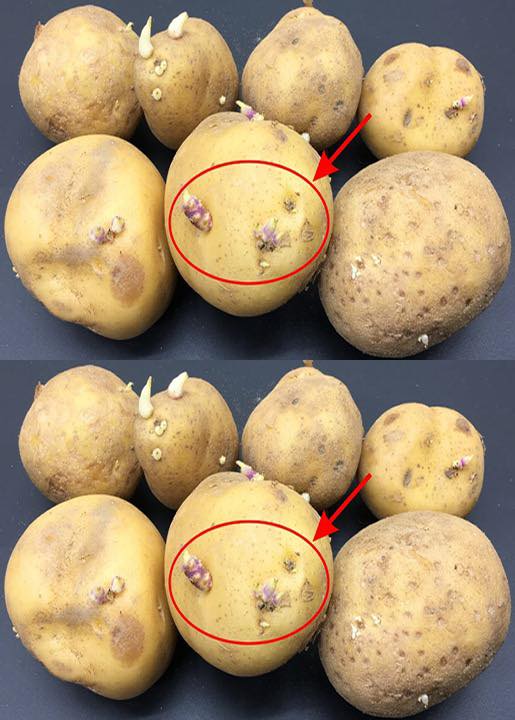Take advantage of the full potential of sprouted potatoes, a resource full of possibilities.
Every month, the same situation repeats itself: fruits, vegetables and greens end up forgotten in the refrigerator and end up spoiling.
Some foods show obvious signs of being overcooked, but others, like potatoes, can raise questions.
When stored for a long time, potatoes can develop small shoots, a sign that they are using their reserves to try to generate a new plant.
Along with these sprouts, it is common for greenish spots to appear on the bark — and although they seem harmless, these signs require attention.
It is common that, when you see potatoes starting to sprout, the immediate reaction is to throw them away.
However, this seemingly harmless gesture represents a waste of food that could still have several useful purposes.
In this post, you’ll discover how sprouted potatoes can be safely and creatively reused—both for home care and home gardening.
Be aware of toxicity
Not all potatoes with sprouts are suitable for consumption.
This is because, when they begin to sprout, they can produce solanine, a toxic substance that acts as the plant’s natural defense.
Although invisible and odorless, solanine can cause unpleasant effects, such as nausea and malaise, if ingested in excess.
An important visual alert is the greenish hue of the bark and the size of the sprouts.
Very green potatoes or those with large sprouts should be avoided in your diet.
Some people have a higher tolerance to solanine due to genetic factors, but this is a rare case.
Therefore, it is best to act with caution, as excessive consumption of this substance can cause food poisoning and trigger a series of complications, such as the following symptoms:
-
- Feeling dizzy
- Nausea
- Vomiting
- Diarrhea
- Abdominal discomfort
- Headache
Creative uses indoors
Even though they’re no longer suitable for cooking, these potatoes still have great everyday uses. Here are some examples:
-
- Stain removal: Rubbing sprouted potatoes with salt on grease or blood stains helps loosen dirt from clothes.
- Kitchen cleaning: Use potatoes as a natural sponge to degrease sinks and surfaces.
- Be careful with leather shoes: rubbing the potato on the leather helps to soften the material and enhance its shine.
- Shine stainless steel utensils: Cut the potato in half and rub it on the pieces to remove marks and restore shine.
- Cleaning glass and mirrors: the starch in potatoes makes it easier to remove grease and makes everything more transparent.
- Removing rust from tools: A practical way to deal with rusty tools is to rub them with slices of raw potato, followed by a dip in wood ash. The starch in potatoes helps loosen the rust, making it easier to clean and restore the metal.
- Glue residue and dirt on your hands: Before washing your hands as usual, try rubbing a slice of raw potato on your skin. The released gum helps soften residue, making it easier to remove glue, dirt, and other stuck-on substances.
- Composting: Potatoes and their peels are excellent for composting. By reusing them this way, you reduce the volume of waste sent to landfills, help reduce methane (CH₄) emissions, and also obtain a high-quality organic fertilizer.
- Floral Arrangements : Want to create an arrangement with long-stemmed flowers but don’t have the proper supports to keep them steady? A simple solution is to cut a potato in half and use it as a base. Stick the stems into the potato so they stay in the ideal position on the table.
- Growing geraniums : Raw potatoes can also be used to grow geraniums. They provide nutrients that aid plant development. Simply make a small hole in the potato, insert the geranium stem, and then plant the entire plant in a pot filled with soil.
Reuse in planting
Another alternative is to start growing potatoes using those that have already started to sprout.
Simply choose a pot or space with soil, position the sprouts facing upwards, cover with soil and maintain humidity.
With patience and care, in a few months you will be harvesting fresh potatoes, reducing waste and saving money.
This practice is ideal for those who want to start a vegetable garden at home, even without previous experience.
How to prevent potatoes from turning green and sprouting?
If your potatoes were in good condition when you bought them, but after a few days at home they started to show green spots and sprouts, the problem may be in the way they were stored.
To better preserve this food, it is best to store it in an airy, dark, and dry environment.
A good alternative is to use paper bags (like those from bakeries), metal baskets or fruit bowls placed away from sunlight.
Another preservation technique is to store potatoes in cardboard boxes lined with absorbent paper.
Avoid stacking potatoes or leaving them in direct light. Also, sprinkle baking soda between them to control moisture.
Leave the box in a cool, well-ventilated place and keep it off the floor to prevent moisture buildup.
Please remember: it is not recommended to store potatoes in the refrigerator.
By following these guidelines, your potatoes can last for several months without losing quality.
Important considerations
- Cooking green potatoes does not eliminate solanine, as the toxin is heat resistant.
- People without genetic tolerance to the substance should avoid consumption completely.
- Use sprouted potatoes wisely: for cleaning, home care, or growing.
- If you still choose to cook, remove all the green part or sprouts before preparing.
Sprouted potatoes don’t have to go straight to the trash. With care and creativity, they become practical and sustainable solutions for a variety of everyday situations.
Whether it’s for cleaning the house, reusing food, or growing at home, this common food can offer much more than it seems. The key is to know, care for, and use it responsibly.



